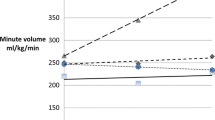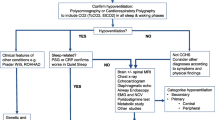Abstract
Co-occurrence of congenital central hypoventilation syndrome and Hirschsprung disease is known as Haddad syndrome. Affected patients develop with variable expressivity a dysfunction of the autonomic nervous system. We report the natural history of a full-term newborn infant presenting multiple features of autonomic system dysfunction that were already noted antenatally. The presence of a nonpolyalanine repeat expansion mutation in the PHOX2B gene confirmed postnatally the diagnosis of Haddad syndrome. This case suggests that patients presenting with autonomic system dysfunction may already present signs of the disease during the fetal period. Furthermore, antenatal presentations may correlate with a more severe presentation of the disease. In conclusion, antenatal signs of dysautonomy should stimulate multidisciplinary prenatal approach to orientate proper postnatal intervention and facilitate treatment strategies.
Similar content being viewed by others
References
Amiel J, Laudier B, Attie-Bitach T, Trang H, de Pontual L, Gener B, Trochet D, Etchevers H, Ray P, Simonneau M, Vekemans M, Munnich A, Gaultier C, Lyonnet S (2003) Polyalanine expansion and frameshift mutations of the paired-like homeobox gene PHOX2B in congenital central hypoventilation syndrome. Nat Genet 33:459–461
Berry-Kravis EM, Zhou L, Rand CM, Weese-Mayer DE (2006) Congenital central hypoventilation syndrome: PHOX2B mutations and phenotype. Am J Respir Crit Care Med 174:1139–1144
Haddad GG, Mazza NM, Defendini R, Blanc WA, Driscoll JM, Epstein MA, Epstein RA, Mellins RB (1978) Congenital failure of automatic control of ventilation, gastrointestinal motility and heart rate. Medicine (Baltimore) 57:517–526
Majumdar S, Wood P (2009) Congenital central hypoventilation syndrome (CCHS) with Hirschsprung disease (Haddad syndrome): an unusual cause of reduced baseline variability of the fetal heart rate. J Obstet Gynaecol 29:152–153
Matera I, Bachetti T, Puppo F, Di Duca M, Morandi F, Casiraghi GM, Cilio MR, Hennekam R, Hofstra R, Schober JG, Ravazzolo R, Ottonello G, Ceccherini I (2004) PHOX2B mutations and polyalanine expansions correlate with the severity of the respiratory phenotype and associated symptoms in both congenital and late onset central hypoventilation syndrome. J Med Genet 41:373–380
Sagel SD, Cohen H, Townsend SF (1999) Neonatal Hirschsprung disease, dysautonomia, and central hypoventilation. Obstet Gynecol 93:834–836
Trang H, Boureghda S, Denjoy I, Alia M, Kabaker M (2003) 24-hour BP in children with congenital central hypoventilation syndrome. Chest 124:1393–1399
Trochet D, de Pontual L, Straus C, Gozal D, Trang H, Landrieu P, Munnich A, Lyonnet S, Gaultier C, Amiel J (2008) PHOX2B germline and somatic mutations in late-onset central hypoventilation syndrome. Am J Respir Crit Care Med 177:906–911
Weese-Mayer DE, Silvestri JM, Menzies LJ, Morrow-Kenny AS, Hunt CE, Hauptman SA (1992) Congenital central hypoventilation syndrome: diagnosis, management, and long-term outcome in thirty-two children. J Pediatr 120:381–387
Weese-Mayer DE, Berry-Kravis EM, Ceccherini I, Keens TG, Loghmanee DA, Trang H (2010) An official ATS clinical policy statement: Congenital central hypoventilation syndrome: genetic basis, diagnosis, and management. Am J Respir Crit Care Med 181:626–644
Ethical standards
The next of kin gave their written informed consent for the publication of their child’s case report.
Conflict of interests
The authors report that no conflicts of interest exist.
Author information
Authors and Affiliations
Corresponding author
Rights and permissions
About this article
Cite this article
De Montpellier, S., Sznajer, Y., Amiel, J. et al. An unusual cause of fetal hypomobility:congenital central hypoventilation syndrome associated with hirschsprung disease. Eur J Pediatr 173, 1607–1609 (2014). https://doi.org/10.1007/s00431-013-2171-8
Received:
Accepted:
Published:
Issue Date:
DOI: https://doi.org/10.1007/s00431-013-2171-8




